 The sculpture-painting, “The Figure Rising,” by artist James Hueter has been acquired by The Huntington Library, Art Collection and Botanical Gardens in San Marino, CA, for their permanent collection of American Art. James studied art at Pomona and received his M.F.A. at CGS. He has been an active artist since then and continues to show and work. A 60-year retrospective of his work, curated by Steve Comba, associate director of Pomona College Museum of Art, was shown at the Claremont Museum of Art in 2009, and he will have a show at Bunny Gunner Gallery in Claremont in May 2016. See photo of James with his work at the Huntington. He and his family had a private tour of the gallery space in Jan. with Hal Nelson, curator of Decorative Art, and Jessica Todd Smith, chief curator of American Art.
The sculpture-painting, “The Figure Rising,” by artist James Hueter has been acquired by The Huntington Library, Art Collection and Botanical Gardens in San Marino, CA, for their permanent collection of American Art. James studied art at Pomona and received his M.F.A. at CGS. He has been an active artist since then and continues to show and work. A 60-year retrospective of his work, curated by Steve Comba, associate director of Pomona College Museum of Art, was shown at the Claremont Museum of Art in 2009, and he will have a show at Bunny Gunner Gallery in Claremont in May 2016. See photo of James with his work at the Huntington. He and his family had a private tour of the gallery space in Jan. with Hal Nelson, curator of Decorative Art, and Jessica Todd Smith, chief curator of American Art.
Blog Articles
Artwork by James Hueter ’46 Acquired by The Huntington Library
New Work by Linda Kawasaki Yoshizawa ’78
 A new work by Linda Kawasaki Yoshizawa ’78 was included in the visual arts portion of the 10th annual “East Meets West” art and poetry exhibit, integrating visual and literary arts, held in the Civic Center at the main Livermore, California, library. Yoshizawa is a printmaker from the San Francisco Bay Area whose artwork reflects the mixing of two cultural sensibilities—American and Japanese. Her nature-inspired drawings are used as symbols of our own struggles and yearnings. She uses colors, values, and textures to elicit mood, questions, and a sense of serenity. Her monotype printing technique balances serendipity and design with a personal aesthetic that reflects her Japanese-American identity. An art major at Pomona, she is a member of the California Society of Printmakers and the Los Angeles Printmaking Society. Her work is included in many personal and corporate collections across the country, including Kaiser Permanente in San Ramon and Pleasanton, California.
A new work by Linda Kawasaki Yoshizawa ’78 was included in the visual arts portion of the 10th annual “East Meets West” art and poetry exhibit, integrating visual and literary arts, held in the Civic Center at the main Livermore, California, library. Yoshizawa is a printmaker from the San Francisco Bay Area whose artwork reflects the mixing of two cultural sensibilities—American and Japanese. Her nature-inspired drawings are used as symbols of our own struggles and yearnings. She uses colors, values, and textures to elicit mood, questions, and a sense of serenity. Her monotype printing technique balances serendipity and design with a personal aesthetic that reflects her Japanese-American identity. An art major at Pomona, she is a member of the California Society of Printmakers and the Los Angeles Printmaking Society. Her work is included in many personal and corporate collections across the country, including Kaiser Permanente in San Ramon and Pleasanton, California.
President Oxtoby Plans to Step Down in 2017
 President David Oxtoby has announced plans to step down as president of Pomona College at the end of June 2017, bringing to a close what will then be a 14-year tenure. He informed the Board of Trustees of his plans at their February meeting to give the institution ample time to conduct a search for his successor.
President David Oxtoby has announced plans to step down as president of Pomona College at the end of June 2017, bringing to a close what will then be a 14-year tenure. He informed the Board of Trustees of his plans at their February meeting to give the institution ample time to conduct a search for his successor.
“I am very proud of Pomona College and grateful for the years spent here, and for the successful conclusion of Campaign Pomona: Daring Minds,” he said in an email to the college community. “While I am considering opportunities I might pursue, my highest priority will remain leading this amazing institution in the months ahead. I am confident that the leadership and expertise of our faculty, the experience of our staff, the determination and talent of our students, and the time we have to partner together on shared goals will make this a smooth transition and allow us to remain focused on the critical work at hand. We also have so much to enjoy and learn each day on our campus and in our classrooms. I appreciate the support I received from Board members and I am committed to continuing to advance the College’s key priorities and the successful operations of the institution.”
Board Chair Sam Glick ’04 said the College will make plans to celebrate President Oxtoby’s many contributions to the College at an appropriate time. Meanwhile, he said, the Board will begin the task of choosing the 10th president of Pomona College. “Selecting a new leader is the highest duty a governing body has—a duty that my colleagues on the Board and I intend to carry out with humility and careful deliberation.” Glick said.
Bookmarks
 What’s Stressing Your Face?
What’s Stressing Your Face?
In this “doctor’s guide to proactive aging and healing,” dermatologist and cosmetic surgeon Dr. Glynis Ablon ’88 discusses a variety of stress-related conditions, from rosacea to hair loss, psoriasis to shingles, along with treatments ranging from psychotherapy to electrical stimulation. (Basic Health Publications, 2015; 184 pages; $15.95)
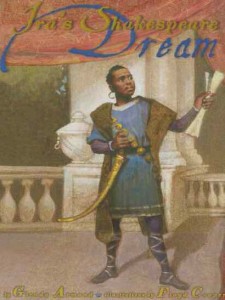 Ira’s Shakespeare Dream
Ira’s Shakespeare Dream
Glenda Armand ’75 joins with illustrator Floyd Cooper to tell the true story of Ira Aldridge, an aspiring Black actor who defied convention and prejudice to become one of the most celebrated Shakespearean actors of the 19th century. (Lee and Low Books, 2015; 40 pages; $18.95)
Leopards at My Door
Harriet Denison ’65 recalls her adventurous years in the Peace Corps during the mid-1960s, teaching at the Bwiru Girls’ Secondary School in Tanzania (where she had regular visits from leopards and an array of other wildlife), and later on, her work with Mother Teresa in Calcutta, India, treating people afflicted with leprosy. (Peace Corps Writers, 2014; 252 pages; $15.00)
Nelson Mandela
In her second book for young readers, Beatrice Gormley ’64 offers a moving biography of South African civil rights activist, long-time political prisoner, author, Nobel Prize winner and eventually President Nelson Mandela, exploring the man behind the iconic smile—his struggles, his triumphs, and the sacrifices he had to make along the way. (Alladin, 2015; 256 pages; $17.99)
Our Dried Voices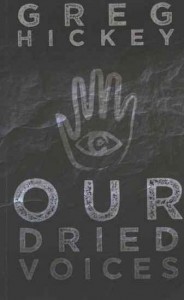
This science fiction novel by Greg Hickey ’08 offers a vision of a far-distant future in which colonists on a planet called Pearl, where there is no longer any need for human labor, conflict or thought, suddenly find themselves struggling with the sabotage of the machines that their utopian lives depend upon. (Scribe Publishing Co, 2015; 234 pages; $13.99)
The Panchen Lama’s Debate Between Wisdom and the Reifying Habit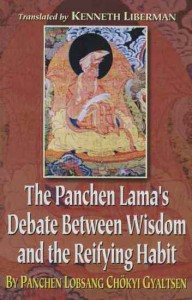
Kenneth Liberman ’70 spent a decade translating the principal work of the renowned first Panchen Lama, Lobsang Chökyi Gyaltsen (1570–1662), styled as a witty philosophical text employing the tension between shes rabs (wisdom) and bdag ’dzin (the reifying habit) as dramatic characters. (Motilal Banarsidass, India, 2014; 224 pages; $35.00)
Loving LA the Low Carbon Way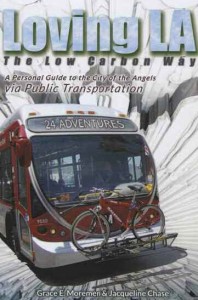
Grace Moremen ’52 and Jacqueline Chase offer a guide to the City of Angels by Metrolink, subway, light rail and bus, with 24 adventures that include such destinations as the Griffith Observatory, Watts Towers, the Observation Deck at City Hall, the Tar Pits and many other treasures hidden in plain sight. (Dream Boat Press, 2015; 230 pages; $15.00)
The Best Kind of College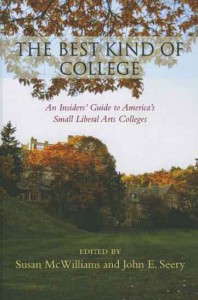
Subtitled “An Insiders’ Guide to America’s Small Liberal Arts Colleges,” this set of essays, edited by Pomona Professors Susan McWilliams and John E. Seery, makes the case for the continuing importance of small, residential liberal arts colleges as a key part of America’s higher education smorgasbord. (SUNY Press, 2015; 314 pages; $80.00)
Daily Life in Wartime Japan, 1940–1945
Pomona Professor Samuel Yamashita’s new book puts a human face on wartime Japan, with an intimate picture of what life was like for ordinary Japanese during the war. Drawing upon diaries and letters written by
servicemen, kamikaze pilots, evacuated children and many others, he lets us hear the rich mix of voices speaking during the course of the war. (University Press of Kansas, 2016; 256 pages; $29.95)
The Freedom to Work

WORK RULES! INSIGHTS FROM INSIDE GOOGLE THAT WILL TRANSFORM HOW YOU LIVE AND LEAD BY LASZLO BOCK ’93 TWELVE, HACHETTE BOOK GROUP, 2015 416 PAGES | $30
The reviews for Work Rules! by Google’s Vice President for People Operations Laszlo Bock ’93 have been, to say the least, laudatory. Forbes.com called it “a masterpiece.” Tom Gardner, founder and CEO of Motley Fool, called it “the finest book on organizational culture that I have ever read.” So this spring, PCM Editor Mark Wood sat down with Bock (long distance) to talk about how the book came about.
PCM: Tell me how you came to write Work Rules! Is it something you’ve been thinking about for a long time?
Bock: Yes, it has been, actually. Not about writing a book, but I’ve been thinking for a long time about how work really kind of sucks for too many people. Work is just not fun. I’ve got a great job. I love what I do. And even I have lousy days. But if I think about jobs I’ve had in the past, the jobs my friends and classmates have, work just sucks way more than it should.
And I realized it actually doesn’t have to. There’s actually a lot of things we’ve done and studied at Google, as well as great things other companies have done, about how to make work better, have a better, more meaningful, more fulfilling, more impactful, more productive experience, without spending money. I got it in my head to tell that story about how you can do that.
PCM: I was struck by how optimistic you are about people. Is that something you’ve always felt?
Bock: I’ve always felt you could learn something from everyone around you. I remember a philosophy class in high school that was just a complete random mix of people from all kinds of different backgrounds—kids who were stoners, kids who were into punk rock, kids who were never, ever going to go to college and a very few who had a background like mine, with two parents with master’s degrees. By the end of it, I absolutely learned something from every single kid in that class. I realized you can learn from the people all around you. Whatever they look like on the outside, whatever baggage they bring, whatever damage they have or trauma they’ve been through, there’s just a core of goodness in there. There’s something they can teach you if you just take the time to open your ears and listen.
That, I think, has informed not just a lot of things I’ve done in my life, but also the book. It’s premised on the notion that you have to ask yourself, “Are people good or are they evil?” If you believe they’re good, you have to treat them that way and act that way.
PCM: Reviewers have called Work Rules! “unconventional,” “innovative,” “surprising.” What would you say is the most revolutionary idea in the book?
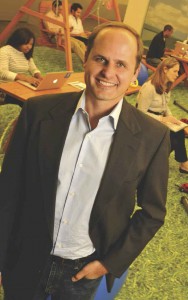 Bock: I think the biggest thing is, “Don’t trust your instincts,” or as I write, “Don’t trust your gut.” We have all kinds of biases. Our instincts and intuition feel good. The problem is we’re wrong most of the time.
Bock: I think the biggest thing is, “Don’t trust your instincts,” or as I write, “Don’t trust your gut.” We have all kinds of biases. Our instincts and intuition feel good. The problem is we’re wrong most of the time.
For example, it feels good when we interview somebody and find out that they like the same teams or they went to the same school. Turns out, those are terrible reasons to hire somebody.
It feels good when you’re hungry to reach in the fridge and grab whatever is at eye level and convenient. The problem with that is: what’s at eye level and convenient tends to be sugary snacks and sugary drinks which are actually bad for you.
It feels good to be able to tell everybody we pay everyone fairly because everyone makes the same money. The reality is your best people generate way more value than your average people and you’re actually disadvantaging them if you pay them all the same or within 10 percent or 20 percent. So our instincts on how to manage people are just wrong.
PCM: I’ve always thought the skills you need to excel in a standard interview usually aren’t the skills you need to do a good job.
Bock: You’re absolutely right. Most people that are doing interviews don’t know how to interview. I’ve been back to Pomona a few times, to talk to students about how to write a resume, how to interview, questions you can anticipate. “Tell me about yourself. What’s your greatest strength, greatest weakness?” None of those common interview questions tell you anything about whether the person is going to be good in the job.
The only questions that do are questions that actually say, “Give me an example of work you did that is exactly like the work you’re going to do.” They’re called “structured behavioral interview questions.” Everything else is kind of a waste of time.
PCM: At one point in the book, you say, “We want owners not employees.” What do you mean by that?
Bock: Ideally, here’s what it boils down to. If there’s garbage on the floor or a scrap of paper left in a conference room, you want people who are going to pick it up and throw it away. You want people who think this is their company or team or department. The reason is those people are always going to do the right thing rather than just doing what’s in their short-term interests. As a result, you end up better serving your customers, your shareholders, and your users.
PCM: There are a lot of little maxims in this book, and one of my favorites is, “If you’re comfortable with the amount of freedom you’ve given your employees, you haven’t gone far enough.” Tell me about that.
Bock: The secret to growing and developing is you just keep giving people more freedom. As long as you give them more, they get excited, they feel challenged, they grow and do great work. But our impulse is to titrate that out very slowly when we think they’re ready for it rather than saying, “You know, this is an amazing person. I don’t know what’s going to happen and it may blow up, but I’m going to make a bet on that person.” That’s uncomfortable and scary, because as a manager, you’re on the hook for that person’s results. But you have to remember, too, that you’re also an employee, and what you want more than anything else is for your own manager to get out of your way and give you a bunch of freedom. So remember that and get uncomfortable.
PCM: How does that high-freedom workplace work in real life? Do you have to be able to tolerate a little bit of anarchy?
Bock: Yeah. Part of the way we solve for it at Google is: there’s a tremendous belief in transparency. It’s okay to ask anyone what they’re doing, and people post their goals on our internal website, so you can see what everyone is working on all the time. What’s beautiful about that is: you have all this freedom, but as one of our executives, Jonathan Rosenberg, used to say, “Trust but verify.” I think that was Ronald Reagan’s cold war maxim.
You give people freedom, you just check on them once in a while to see how things are going, and 99 times out of 100, they’re doing great stuff. So there is a little bit of anarchy, and you try to observe what’s going on without jumping in and telling people, “You can do this; you can’t do this other thing.”
PCM: You say one of the things you’re looking for in hiring is “emergent leadership.” What do you mean by that and how do you find it?
Bock: The conventional model of leadership is somebody who stands at the bow of the ship and says, “Onward. We’re going in this direction.” The problem is that one person isn’t going to have the best judgment in the world in every situation, and they may be sending you in the wrong direction. If you want to retain your best people and keep them motivated, you actually have to let them all lead in some different way.
Rather than having a single person saying, “This is the way it’s going to be,” what we focus on is emergent leadership. When there’s a problem, let somebody emerge as a natural leader. Do they actually take charge? And just as importantly, do they relinquish control? Do they then let go and let somebody else step in? Those are the things we look for.
Larry [Page] and Sergey [Brin], in running Google, have done this multiple times. They could have said, “I’m going to make every decision. Here’s how it’s going to go.” But instead, most recently, they handed off the position of CEO of Google—the crown jewel of the company, the big source of revenue—and they just gave it to Sundar Pichai, who is fantastic. So they’re willing to lead and step back, lead and step back. And that’s essential because, while in conventional leadership theory, there is a leader who is the right leader who is going to lead in all situations, the reality is we all have different strengths and weaknesses, and we will be most effective as leaders in very different kinds of circumstances. There’s no one person who is the right leader all the time.
The way we screen for that, quite frankly, is pretty boring. We structured these interview questions where we basically said, “Give me an example of a time you led a team,” or “give me an example of when your leadership led to solving a problem.” And the signifiers that everyone knows about are things like: people who say “we” a lot, people who describe taking power and letting go of it, people who describe a lot of collaboration. Those people tend to do better in the interview process.
PCM: How do you answer critics who say this culture of empowerment is a luxury item that’s particular to Google?
Bock: That’s probably the most common question I get. The answer is, “It’s not at all unique to Google.” One of the cool things about writing a book is that you get to look for lots of data that either support or deny your argument. I was pleasantly surprised to see how many companies and organizations in very different circumstances choose to be high-freedom environments, and they don’t have to spend a lot of money. I talk about Wegmans, which is a Northeast grocery chain, complete opposite of Google. Family-led firm. Most people have a high school education at best. It’s regional. Their margins are 1 percent or 2 percent. But their values in terms of how they treat their people, the freedom they give their people, is a mirror image of what we do at Google.
There was a study done of two different Nike plants in Mexico, making tee shirts. One was very conventionally run. In the other, basically, the workers were told, “You all figure it out.” They doubled productivity when the workers were told, “You figure it out.”
Going back to your first question, the conventional approach is, “Well, I’m the boss, I know best. I’m going to tell people what to do. And by the way, my butt’s on the line, so I’m going to watch you very closely and make sure you deliver.” The reality is all of us hate to be managed like that. If you just get off our backs and give us some freedom, we’ll do our jobs and we’ll do great work. And that’s true in 99.9 percent of the cases. Anyone can do it.
PCM: Tell me about the response to the book so far?
Bock: It’s been surprising, and humbling, and flattering, and exciting, and a little embarrassing. The book came out last April. It’s out now in 11 languages. There’s another 10 to be published this year. Mainland Chinese just came out this last week, but World Arabic, for example, is coming out, I think, next month. So the appetite for it has been surprising. It’s kind of humbling and delightful. The critical reception was a huge relief, because I was terrified people were going to say, “This doesn’t make any sense. The math is wrong. The science doesn’t hold up.” Thanks to the analytics folks here, we dodged that bullet.
But the best thing is the emails and letters I get from people who have read it. I bump into people who say, “Hey, I got my job because I read your chapter on how to hire.” I got an email from a Pomona alumnus who’s got a law firm in Claremont. He said, “Hey, I read the book and I tried instituting spot bonuses in my company where people can give anyone a bonus. It’s been great. It’s been really cool.” So the direct feedback from people, saying, “I’m actually changing how I run my business, and people are happier,” has been amazing, and kind of surprising and delightful.
PCM: Do you have another book in mind?
Bock: I don’t know. Maybe. I think there’s a really tough problem around how to find a job. I’ve been thinking about what would be the most helpful way to help people find jobs. This book was sort of from the corporate side—if I’ve got a business or a team, how do I select people and how do I manage them?
The flip side of that is: if I’m a new grad, or if I’m out of work, or if I’m underemployed, or if I’m somebody who stepped out of the workforce for 10 years to start a family, how do I get back in? I think that’s a really hard question so I’ve been thinking about that.
Language & Relationships

Student Ani Alyce Schug ’17 (center) works with housekeeping staff members Rosario Osorio and Beatriz Tovar on an English lesson.
Mastering a second language is no easy feat, but it gets easier when you have help. At Pomona College, employees wishing to learn or improve their English have been getting assistance from students for more than 10 years now.
Employees gain language skills and students learn teaching skills, but at the core of the program are the relationships developed between students and the employees who often work in the background in housekeeping, dining services and grounds and are integral in keeping the College running smoothly.
Math major Luis Antonio Espino ’18, a student coordinator for the program, joined for very personal reasons. “As a first-generation immigrant, I grew up being a translator for my parents,” he says. “I dealt with the troubles of having to go to the doctor and seeing my parents struggle through that. That was one of the reasons I was interested in the doing the ESL program.”
Espino says that while in college, students are encouraged to develop strong ties with faculty, but he sees connecting with staff members as equally important. “One of the goals is to bridge that gap and have students recognize everyone’s equal worth,” he says.
Ani Alyce Schug ’17, a politics major who studies Arabic, Spanish and Swahili and grew up speaking Armenian, is in her second year as a student coordinator for the program, which is run by the Draper Center for Community Partnerships.
“It’s one of my favorite parts of being at Pomona,” says Schug, adding that while the majority of employees choose to learn English, some are looking for help in areas such as computers and GED prep.
“This is my first time taking ESL classes,” says Rosario Osorio, who emigrated from Mexico 12 years ago and now works in housekeeping. “We, unfortunately, arrive to this country to work and don’t have the financial means to go to school and take classes because we must immediately find work, and we have children to raise. But thanks to students at Pomona, we have this opportunity and we should take advantage of it.”
An Observer in Paris

“Massive, exciting, chaotic and a bit overwhelming.” That’s how Olivia Voorhis ’16 described her time as an official observer of COP21, the United Nations conference on climate change held last December in Paris, where delegates of 195 countries came together to try once again to negotiate a global climate agreement.
In halls she describes as “the size of jet hangers,” she encountered languages and dress from around the globe and attended dozens of lectures and panels and a range of side events. “There were thousands upon thousands of people, from scientists and researchers to activists, media and government representatives,” she says.
In all, she spent a week in Paris, focusing mainly on ways in which World Wide Views, a global citizen consultation initiative, might become a more effective part of the international policy-making process.
She doubts that the COP21 agreement, which was signed after she left Paris, will achieve everything environmentalists had hoped for, but she believes the conference is a step forward becasue it focused global attention on the problems. “I think the global community left COP21 with admirable goals,” she says, “but now comes the extremely difficult and politically contentious work of implementation.”
I Speak Karaoke
 Song requests for a recent Karaoke Klub Nite included: Vicente Fernandez’s “El Rey” in Spanish, Aamir Khan’s “Mitwa” in Hindi, Les Cowboys Fringants’ “En Berne” in Canadian French, and a few Demi Lovato and Celine Dion songs thrown in for good measure.
Song requests for a recent Karaoke Klub Nite included: Vicente Fernandez’s “El Rey” in Spanish, Aamir Khan’s “Mitwa” in Hindi, Les Cowboys Fringants’ “En Berne” in Canadian French, and a few Demi Lovato and Celine Dion songs thrown in for good measure.
The once-per-semester celebration brings together international and domestic students to belt out songs in Hindi, Spanish, French, English and other languages.
“International students can sing the songs they really love from back home without feeling guilty about it,” says ISMP Head Mentor Chihiro Tamefusa ’16, who says the discomfort comes from singing in another language that others might not understand. But at karaoke night, she says, everyone can sing whatever song they want. “International students can feel comfortable singing, and for non-international students who are learning a language, they can practice and learn more,” she adds.
Hosted by the International Student Mentoring Program (ISMP) and Oldenborg Center for Modern Languages, the event is open to all students from The Claremont Colleges.
“It is an incredibly fun environment with international and American students singing songs they don’t know in languages they don’t speak,” says Lazaros Chalkias ’16, an ISMP member.
Treasured Map
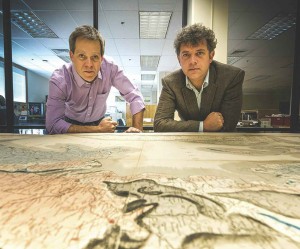
Professors Robert Gaines and Jade Star Lackey examine the restored map.
Two centuries ago, surveyor and geologist William Smith completed the ambitious task of mapping the geology of an entire nation. His detailed, hand-colored geological maps of England and Wales, published in 1815, changed the course of geology and remain among the field’s most treasured artifacts. (One of the remaining maps was recently made available for sale in Great Britain for £150,000.)
So it’s something of a feather in the cap of Pomona’s Geology Department that it is the proud owner of not one, but two of the historic maps. And with the bicentennial of the map’s release last year, one of them was brought out of safekeeping in the Special Collections of Honnold-Mudd Library to be restored.
“Because of the bicentennial, we felt it was the right time to renovate the map,” says Geology Professor and Chair of the Geology Department Jade Star Lackey. “It’s a great piece of history that we think all geology majors should be able to come and see.”
Because of the map’s size (more than two and a half meters wide), the restorers had to set up an aluminum platform over the top of the map to work from. Even so, the conservation process took nearly two months, including dry cleaning front and back, removal of a damaged cloth backing, wet cleaning, lining with Japanese paper and wheat starch paste, and mending tears.
The result is impressive to behold, not just for the brilliant and colorful detail in drawing and watercolor, but also for the rich history and monumental shift it caused in the field of geology.
“The map is a turning point of understanding that the pattern of nature has an order, that resources like coal or limestone are not just randomly scattered about the surface of the Earth,” says Geology Professor Robert Gaines. “This map actually makes predictions about what’s going on underground, and it suggests there is a recognizable order.”
Tend Your Garden
 Spring is here, and the Organic Farm is bustling, as Pomona students welcome the season by following Voltaire’s advice to “tend your garden.” According to Farm Manager Scott Fleeman, March harvests have already included kale, collards, broccoli, Swiss chard, radishes, snap peas, fava beans, bunching onions and tangerines, as well as the first artichokes. Here’s a partial harvest schedule for the rest of the spring:
Spring is here, and the Organic Farm is bustling, as Pomona students welcome the season by following Voltaire’s advice to “tend your garden.” According to Farm Manager Scott Fleeman, March harvests have already included kale, collards, broccoli, Swiss chard, radishes, snap peas, fava beans, bunching onions and tangerines, as well as the first artichokes. Here’s a partial harvest schedule for the rest of the spring: